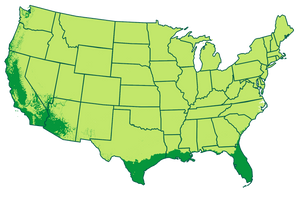* Images shown are of mature plants

Have questions? Talk with our Plant Experts (800) 973-8959
Save 25% on $200+ with code FALL25.
Questions? Call our plant experts: (800) 973-8959
Tropical Fruit Similar to a Pear
Why Sapodilla Trees?
- Slow growing evergreen tree with long lifespan
- Tons of beautiful, glossy green leaves
- Attractive, oval-shaped fruit and bell shaped flowers
- Satisfying fruit flavor similar to a Pear
- Resistant to wind
It may not sound pretty but don't let the name fool you. The Sapodilla is one handsome tree with a ton of benefits. From its long, glossy green leaves to the attractive oval fruit that hangs like large brown eggs, the Sapodilla is quickly gaining recognition among evergreen enthusiasts. The bell-shaped flowers bloom several times a year, adding a colorful burst of pinks and reds that complement the sea of green throughout the tree.
A strong specimen, the Sapodilla has a white, gummy latex that reinforces the tree's trunk which helps it hold up well against strong winds. It's also salt and drought resistant. With great looks and adaptability, the Sapodilla is an excellent choice for a variety of possible planting locations.
What looks like an egg but Tastes like a Pear? Sapodilla!
Take a ripe pear and dip it into brown sugar. Sound flavorful? That's the best way to describe the taste you can expect when you bite into a Sapodilla fruit. Sweet and almost malty, cut it into wedges and serve it chilled for a fantastic treat. This fruit tastes like dessert all by itself. But don't let that stop you from dressing up ice creams, cakes and fruit cups.
Rich in Tannin and vitamin C, Sapodilla is good for the body as well as the palate. With everything it has to offer, there's a spot in your garden or landscape just waiting for a Sapodilla.
Pollination Info
Sapodilla Tree Pollination
Sapodilla Trees are self-fertile. You will get fruit with only one plant. However, adding an additional Sapodilla Tree will drastically increase the size of your crop.
Planting & Care
1. Planting: First, select a spot with well-drained soil and plenty of sunlight for your Sapodilla Tree. Once you've found your location, dig a hole that's about twice as wide as your tree's root ball, place your tree, and backfill the surrounding soil. Finally, mulch and water the surrounding soil to settle the roots.
Note: This product grows best in well-draining soil. When you receive your plant, you may notice small, white beads or rocks in the soil - this medium is added to increase drainage and keep your plant happy and healthy!
2. Watering: Water your Sapodilla about once or twice weekly - enough to keep the soil moist at a depth of about 2 inches. If you're not sure when to water your tree, simply check the soil at this depth.
3. Fertilizing: Use a well-balanced fertilizer or fertilizer made for tropical fruit trees in the spring, before new growth begins. Be sure to follow label instructions.
Shipping Details
Estimated Shipping Time: Most orders ship immediately. As noted on the website, some items are seasonal, and may only ship in spring or fall. Once your order is shipped, you'll receive an email with a tracking number.
| Amount of Order | Shipping Charge |
|---|---|
| Less than $49 | $19.95 |
| $49 + | FREE SHIPPING! |
Product Details
| Mature Height: | 30-50 ft. |
| Mature Width: | 20-30 ft. |
| Sunlight: | Full-Partial |
| Growth Rate: | Moderate Growing |
| Harvest Time: | May-September |
| Botanical Name: | Manilkara zapota 'Alano' |
| Does Not Ship To: | AK, AZ, HI |
| Grows Well In Zones: | 3-11 patio / 9-11 outdoors |
| Your Growing Zone: | # |









